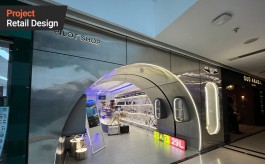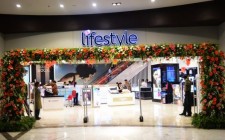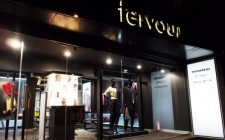Living it up with spice
By Susmita Das | Vjmedia Works | December 13, 2013
The Spice Board of India has given life to a new initiative to promote spices as a healthy life style product and to bring this imagination into effect, an innovation called Spices India has been launched in Kochi, Kerala.
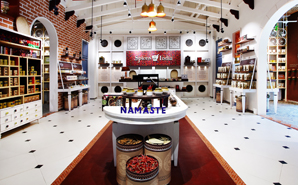 With an interesting demonstration of our Indian roots, the newly launched Spices India store is an expression of Indian culture interpreted for the modern times. This place revolves around various themes ranging from Indian people, culture and art to history, geography, health and cuisine.
With an interesting demonstration of our Indian roots, the newly launched Spices India store is an expression of Indian culture interpreted for the modern times. This place revolves around various themes ranging from Indian people, culture and art to history, geography, health and cuisine."Spices India- a one of its kind signature stall for Spices is an initiative of the Spices Board, India through which we intend to embark on a new journey to promote spices. The signature stall is more than just another retail outlet, its major objective will be to promote a unique brand image to Indian Spices and serve as an experiential centre for customers to touch, smell and feel spices and educate them on various culinary, neutraceutical and medicinal uses of spices,†says Dr. A Jayathilak IAS, Chairman, Spices Board.
Further explaining the business strategy, Dr. A Jayathilak shares, "Our business model focuses on streamlining the efforts of people working at grassroots with market forces. We intend to procure directly from progressive farmers and grassroots organization thus helping spice growers, collectives and developmental ventures to bring the economic and social inclusion. The farmers would actually be able to sell their produce in a state-of-the- art infrastructure which is the Spices India outlet. We are hoping that it will also be a great opportunity for us to uplift India's image in the domestic and international market. We also wanted the outlet to communicate our commitment towards the society and towards promoting sustainability at all levels of our business.â€
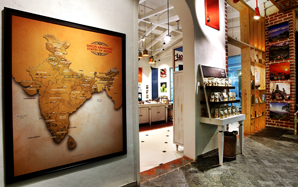 Bangalore based design group, Four Dimensions (4D), was assigned to conceptualise this idea into an exquisite store. "To create an environment around Indian spices arranged in an eclectic contemporary-traditional Indian set up was an interesting challenge indeed! The task was not just creating a befitting environment around these assortments but to create an identity amongst the target audience and help them elevate from their mindset of purchasing spices from the next-door kirana shop. Another primary target audience being the travellers/tourists from various parts of the world, the store had to be more of an experience that would promote Indian spices not only in the country but overseas as well!,†explains Nagaraja R, Director, Design, Four Dimensions (4D).
Bangalore based design group, Four Dimensions (4D), was assigned to conceptualise this idea into an exquisite store. "To create an environment around Indian spices arranged in an eclectic contemporary-traditional Indian set up was an interesting challenge indeed! The task was not just creating a befitting environment around these assortments but to create an identity amongst the target audience and help them elevate from their mindset of purchasing spices from the next-door kirana shop. Another primary target audience being the travellers/tourists from various parts of the world, the store had to be more of an experience that would promote Indian spices not only in the country but overseas as well!,†explains Nagaraja R, Director, Design, Four Dimensions (4D).An assortment of finishes, texture, shapes and hues which complements the Indian architectural language and is also germane to contemporary tastes exemplifies the 1176 sq.ft Spices India. Each and every element crafted in the store has been customized to create a specific language.
This space which intones authenticity sports a very simple and clean front to compliment the busy retail interior. While one side holds the signage in a neat composition with the jaali patterns, the other side is kept transparent to allow the store to showcase itself.
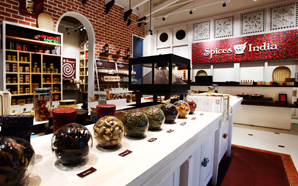 Mostly wrapped with clear glass, the signage is adorned with backlit wood finished letters against a white textured backdrop while the eminent jaali patterns have been modernized and placed on the façade as an articulation of the age old fenestrations. According to Shyam Sunder K, Chief Architect & Director, Four Dimensions (4D), "Like the toranas or the greeting garlands at every Indian door step, the metal moulding above the door height running all along the perimeter of the store, is the first to greet every guest stepping in.â€
Mostly wrapped with clear glass, the signage is adorned with backlit wood finished letters against a white textured backdrop while the eminent jaali patterns have been modernized and placed on the façade as an articulation of the age old fenestrations. According to Shyam Sunder K, Chief Architect & Director, Four Dimensions (4D), "Like the toranas or the greeting garlands at every Indian door step, the metal moulding above the door height running all along the perimeter of the store, is the first to greet every guest stepping in.â€Further speaking about the store design, Shyam explains, "Two walls have been incorporated in the store which forms the spine within the space. These walls have been punctured with arches to get in the architectural flavor in this palette and are finished with white stucco texture and brick. Also a few display units have been incorporated within the walls including the fabric curtains with motifs of spices patterns printed on it, that hang from the top most point of these punctures. Just beside these units are shelves that simulate the Indian kitchen with its spice containers of all kinds. To accentuate this feature we have used cut letters that speak out words like'masala' in Hindi and whole grains.â€
The furniture has been styled in white and polished wood with features borrowed from colonial designs to create a combination of rustic and neat impression. The flooring has been inspired by the black and white checkered flooring of olden times coupled with red oxide floor used as a highlighter. The corridors however are finished with grey slate that defines the space as a pathway. The in-store graphics have been crafted with Rangoli as the muse, wherein an interpretation of the forms of spices is moulded in a composition that forms a Rangoli pattern.
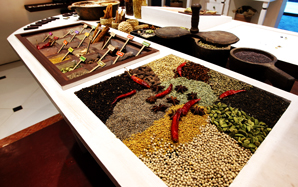 The central space has been designed given the available height, while the corridors have a lowered drop ceiling to match the proportion of the space. Nagaraja explains this further, "The central area showcases the sloped roof of Kerala in white wooden battens supported on dark wooden brackets, while the corridors have jaali patterned drop ceiling neatly finished in wood polish and golden tints.â€
The central space has been designed given the available height, while the corridors have a lowered drop ceiling to match the proportion of the space. Nagaraja explains this further, "The central area showcases the sloped roof of Kerala in white wooden battens supported on dark wooden brackets, while the corridors have jaali patterned drop ceiling neatly finished in wood polish and golden tints.â€Though the entire space appeals to the senses, the biggest attraction of the store lies in its central portion where the spice bar is fashioned. The spice bar sports a long table in rustic white finish with spices, old spice containers, books, facts about spices and a digital experience of blown up spice grain details.
But the drama doesn't end here. The cash back has also been treated tastefully with white wooden frames and jaali patterns. It holds the brand name against a composition of mosaic patterns in spice colors.
Coming to the lighting strategy, tints from the Indian flag have been incorporated in the form of light fixtures in the three galleries, while the chakra has been symbolically depicted with a cycle wheel in a repetitive composition. "Three galleries hold three colors of the light fixture- green, blue and saffron. They are long, sleek and come directly from the ceiling to focus on special arrangements and displays, while the rest of the store is illuminated with tracks that are carefully placed along the store perimeter to highlight the products, cash back and aisles. Besides this, a few fixtures are hung above the spice bar tables that were customized in FRP in the shape of Indian temple bells,†says Nagaraja.
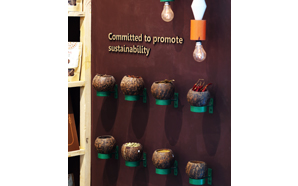 Further, ceramic handles, hand carved wooden bull heads finished in local art patterns, metal door latch & locks, wooden ship, old spice containers from Kochi port, table lamps made in Chenapatna, woven cane baskets from West Bengal, special handmade cane boxes from Nagaland, rustic old spice tins from Karnataka have all equally helped to set the mood within the store.
Further, ceramic handles, hand carved wooden bull heads finished in local art patterns, metal door latch & locks, wooden ship, old spice containers from Kochi port, table lamps made in Chenapatna, woven cane baskets from West Bengal, special handmade cane boxes from Nagaland, rustic old spice tins from Karnataka have all equally helped to set the mood within the store.A customer's lounge has also been created along with a library containing books, visuals, maps related to spices, spice route and Indian culture.
While revealing the future plan, Dr. A Jayathilak sums up, "This is a pilot project and based on its success, the Board has plans to open more such outlets across the country and in overseas markets.â€
Advertisement


